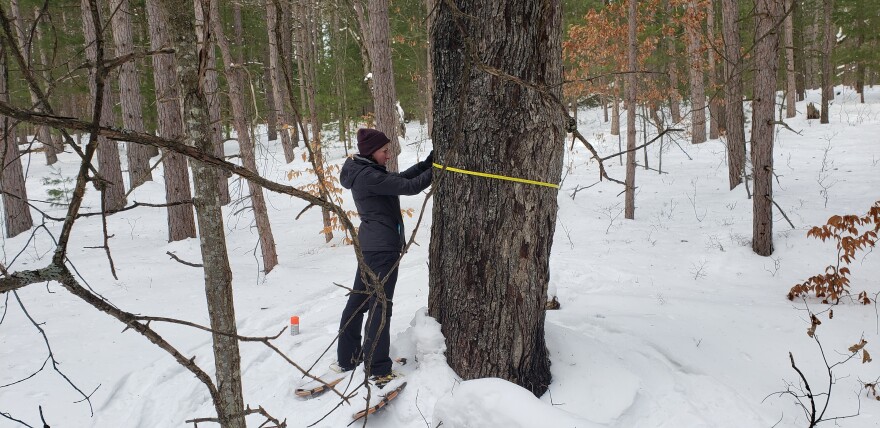Bob Sanders and Angela Kujawa have driven on snowmobile trails near the Manistee National Forest every week this winter following a steady beeping sound.
They’re biologists with the Little River Band of Ottawa Indians and they take turns holding up an antenna and wearing headphones to listen.
The sound comes from a GPS collar on a pine marten. They’re slender, curious mammals related to weasels.
As they approach the marten, the beeps get louder. It’s like hunting through the forest with a metal detector. When Sanders and Kujawa think they’re as close as they can get by road, they make the rest of the journey on snowshoes. They usually find the marten resting in a tree hollow, or peering down from the canopy.

The biologists have collared six animals this winter, as part of a years-long effort to monitor martens in the area and work to revitalize the species.
“We want to know if they’ve expanded, where they’re going, what kind of habitat they’re using, what they’re eating — anything we can use to help us better manage for them,” said Kujawa.
They have more collars they could use, but they haven’t been able to find other martens to put them on. That’s because despite the wildlife managers’ best efforts, martens are a rarity in the woods of lower Michigan.
“I wouldn’t classify this population down here as robust by any means,” said Sanders.
Martens used to live all over the forests of the upper Midwest until settlers came in and cut down stands of white pines and other conifers.
“They logged all this, and all the slash created these huge wildfires and nothing would grow. That’s why you see all these red pines they came and planted.” Sanders said as he walked through the woods.
He pointed to a scattering of white pine stumps he guessed were close to 200 years old. “They’re still hanging on. A lot of them you can see the fire scars still on them.”
While Michigan’s forests were logged and burned, trappers also killed martens for their fur. By the early 1900s, the animals were thought to be eradicated from the lower Michigan and Wisconsin.
It wasn’t until the 1980s when Michigan’s Department of Natural Resources decided to reintroduce the species to the Lower Peninsula.
The department worked out a deal with the government in Ontario, where martens still lived.
“The original plan was to reintroduce the animals over a series of years, and about 200 animals total,” said Paul Keenlance, a wildlife biologist at Grand Valley State University.
That’s not what happened.
The deal with Ontario soured, so state biologists released a total of 85 martens in lower Michigan over a couple months, near the Manistee National Forest and the Pigeon River Country State Forest.
Those animals came from one game preserve. “That probably meant that the martens they were catching were mom, and that year's offspring, and dad,” said Keenlance.
The last marten from Ontario arrived in 1986 and the agency hasn’t introduced any others since.
“We kind of started and we didn't finish,” said Tom Gehring, a biologist at Central Michigan University. “We spent all that time and resources to bring them here, let them go, and then we’re done.”

In recent years, researchers across the state have been trying to get a better handle on why martens haven’t expanded after that initial introduction. Many say the issue isn’t only a lack of genetic diversity from inbreeding. Martens are also picky about where they live. They need thick forests, filled with logs and big trees with cavities where they can hunker down.
“The landscape has some habitat for martens. It doesn’t appear to be ideal,” said Gehring. A lot of this prime marten habitat is cut up into little pieces, separated by highways and farms.
There’s more of these continuous, thick forests in the Upper Peninsula, where martens have done really well. They’ve also gotten a lot more help there. The DNR brought in martens from different regions in Canada over decades, and moved those animals around.
“What they did is everything right to get ahead of inbreeding issues and these little populations getting stuck, like they seem to be in Wisconsin and the Lower Peninsula,” said Gehring. “It’s just night and day.”
He said if we want to see martens succeed in lower Michigan too, we’d need to introduce more animals and conduct intensive follow-up studies, while managing our forests with martens in mind.
That’s something Keenlance, from Grand Valley State, would like to see.
“If we don’t do everything we can and we lose them again, to me that’s worse than what happened in the 1800s,” he said. “We didn’t know any better then. We know better now.”
Biologists from the agency that would largely be responsible for this, the DNR, said they want to keep martens in the Lower Peninsula. But it’s not something they’re actively working on.


